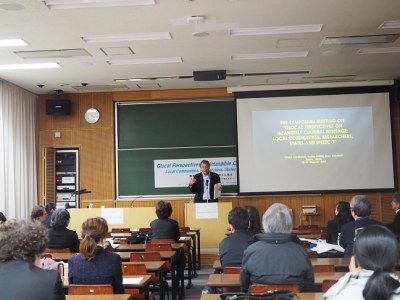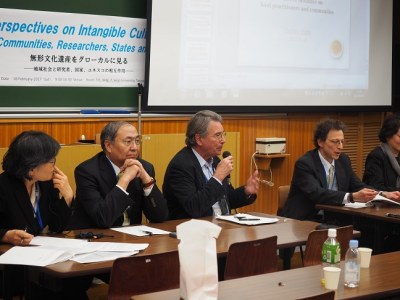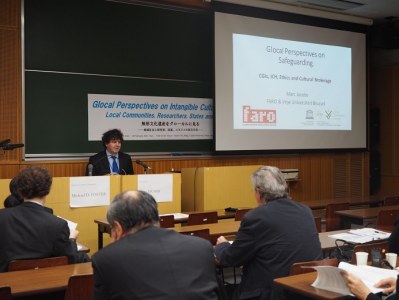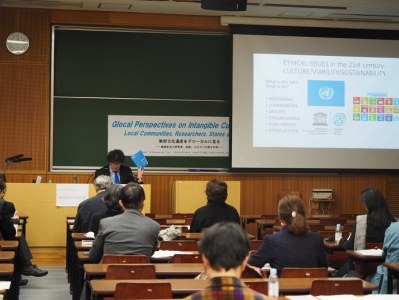

NEWS
2017.03.06
<Synopsis>
On Saturday, February 18, 2017, 9:30–16:30, in Room 731, Building 7 of Seijo University’s campus, the university’s Center for Glocal Studies hosted a pre-symposium to the international symposium, “Glocal Perspectives on Intangible Cultural Heritage: Local Communities, Researchers, States, and UNESCO.” The event formed part of the university’s project to “establish and promote a world-leading glocal-studies center that contributes toward a sustainable and inclusive society” (a MEXT-supported Research Branding Program for Private Universities).
The timetable of the gathering, including the presenters, themes, and coordinator, was as follows.
The guest speakers and attendees were as follows.
At the event, Noriko Aikawa (former head of UNESCO’s Intangible Heritage Section) outlined the background to the ratification of UNESCO’s Convention for the Safeguarding of the Intangible Cultural Heritage, and its outcomes. Aikawa argued that the time has come to revive the channels by which Communities, Groups, and Individuals (CGIs) can engage in the safeguarding of Intangible Cultural Heritage (ICH).
Next, Antonio A. Arantes (State University of Campinas, Brazil) delivered the first of four presentations. In this presentation, Arantes discussed the globally transformative impacts of the ICH Convention, particularly in terms of how its ratification has shined a spotlight on the role of CGIs and given them a voice, while also impacting the cultural policies of national governments.
In the next presentation, Chao Gejing (Chinese Academy of Social Sciences) outlined in detail the process by which UNESCO came to add the rituals and festivities associated with China’s Twenty-four Solar Terms (the 24 segments of the Sun’s annual circular motion) to UNESCO’s Representative List of the Intangible Cultural Heritage of Humanity. Gejing discussed the roles of various actors in this process, including the roles of CGIs and that of local governments, academic institutions, and the media.
Next, Hanhee Hahm (Chonbuk National University, South Korea) outlined the background to South Korea’s ratification of UNESCO’s Convention for the Safeguarding of the Intangible Cultural Heritage, in which the republic’s National Assembly passed legislation to guarantee a voice to the CGIs. This case illustrated how UNESCO’s global-level policies impacted legislation at a national level.
In the fourth presentation, Marc Jacobs (Vrije Universiteit Brussel) argued that the World Heritage Committee and the Committee for the Safeguarding of the Intangible Cultural Heritage have now explicitly recognized the role of CGIs in safeguarding world heritage and ICH, and that they have further recognized the right of CGIs to have a voice in the safeguarding process.
The fifth presentation, by ethnologist Michael Foster (University of California), focused on the inclusion of Japan’s “Raiho-shin, ritual visits of deities in masks and costumes” on the Representative List of the Intangible Cultural Heritage of Humanity. Foster emphasized the perspectives of the CGIs concerning their cultural heritage and how these perspectives are often abstracted at the metacultural level.
The five presentations were followed by commentaries from Satoru Hyoki (Seijo University) and Taku Iida (National Museum of Ethnology, Japan). Both speakers noted that, despite differences in nuance between the presentations, each presentation underscored how important it was to increase the engagement of CGIs in safeguarding ICH.
Following the commentaries, the symposium concluded with a spirited discussion among the attendees, who included members of UNESCO, Japan’s Agency for Cultural Affairs, the Tokyo Research Institute for Cultural Properties, and the International Research Center for Intangible Cultural Heritage in the Asia-Pacific Region. These attendees exchanged various views on future measures to safeguard ICH, and these views encompassed glocal (global and local) perspectives.
The Center for Glocal Studies intends to publish the proceedings of the symposium in the near future, under the title, “Glocal Perspectives on Intangible Cultural Heritage: Local Communities, Researchers, States, and UNESCO.”



